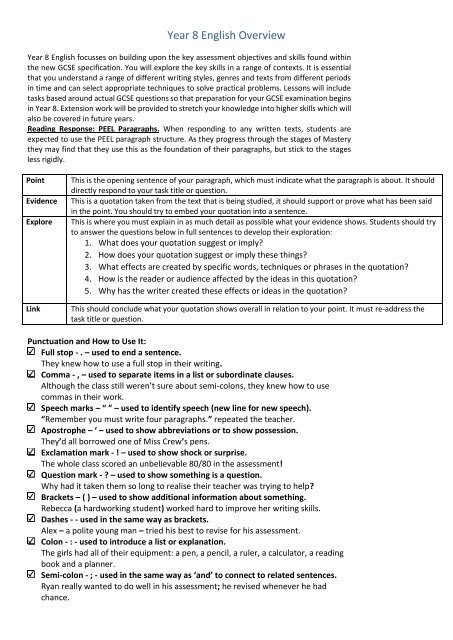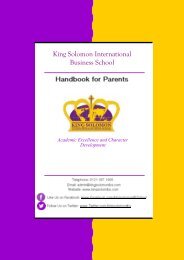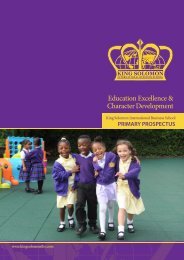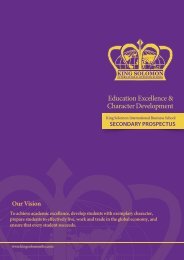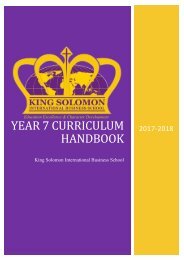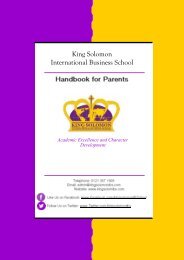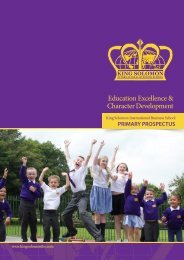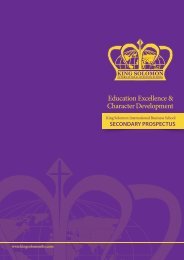Year 8 Curriculum Handbook
Create successful ePaper yourself
Turn your PDF publications into a flip-book with our unique Google optimized e-Paper software.
<strong>Year</strong> 8 English Overview<br />
<strong>Year</strong> 8 English focusses on building upon the key assessment objectives and skills found within<br />
the new GCSE specification. You will explore the key skills in a range of contexts. It is essential<br />
that you understand a range of different writing styles, genres and texts from different periods<br />
in time and can select appropriate techniques to solve practical problems. Lessons will include<br />
tasks based around actual GCSE questions so that preparation for your GCSE examination begins<br />
in <strong>Year</strong> 8. Extension work will be provided to stretch your knowledge into higher skills which will<br />
also be covered in future years.<br />
Reading Response: PEEL Paragraphs. When responding to any written texts, students are<br />
expected to use the PEEL paragraph structure. As they progress through the stages of Mastery<br />
they may find that they use this as the foundation of their paragraphs, but stick to the stages<br />
less rigidly.<br />
Point<br />
Evidence<br />
Explore<br />
Link<br />
This is the opening sentence of your paragraph, which must indicate what the paragraph is about. It should<br />
directly respond to your task title or question.<br />
This is a quotation taken from the text that is being studied, it should support or prove what has been said<br />
in the point. You should try to embed your quotation into a sentence.<br />
This is where you must explain in as much detail as possible what your evidence shows. Students should try<br />
to answer the questions below in full sentences to develop their exploration:<br />
1. What does your quotation suggest or imply?<br />
2. How does your quotation suggest or imply these things?<br />
3. What effects are created by specific words, techniques or phrases in the quotation?<br />
4. How is the reader or audience affected by the ideas in this quotation?<br />
5. Why has the writer created these effects or ideas in the quotation?<br />
This should conclude what your quotation shows overall in relation to your point. It must re-address the<br />
task title or question.<br />
Punctuation and How to Use It:<br />
Full stop - . – used to end a sentence.<br />
They knew how to use a full stop in their writing.<br />
Comma - , – used to separate items in a list or subordinate clauses.<br />
Although the class still weren’t sure about semi-colons, they knew how to use<br />
commas in their work.<br />
Speech marks – “ ” – used to identify speech (new line for new speech).<br />
“Remember you must write four paragraphs.” repeated the teacher.<br />
Apostrophe – ‘ – used to show abbreviations or to show possession.<br />
They’d all borrowed one of Miss Crew’s pens.<br />
Exclamation mark - ! – used to show shock or surprise.<br />
The whole class scored an unbelievable 80/80 in the assessment!<br />
Question mark - ? – used to show something is a question.<br />
Why had it taken them so long to realise their teacher was trying to help?<br />
Brackets – ( ) – used to show additional information about something.<br />
Rebecca (a hardworking student) worked hard to improve her writing skills.<br />
Dashes - - used in the same way as brackets.<br />
Alex – a polite young man – tried his best to revise for his assessment.<br />
Colon - : - used to introduce a list or explanation.<br />
The girls had all of their equipment: a pen, a pencil, a ruler, a calculator, a reading<br />
book and a planner.<br />
Semi-colon - ; - used in the same way as ‘and’ to connect to related sentences.<br />
Ryan really wanted to do well in his assessment; he revised whenever he had<br />
chance.


